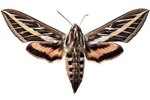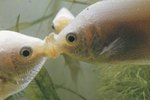There's arguably nothing with a greater "ew" factor than discovering a cuterebra infestation on your pet. That's because the last stage of this parasitical infestation involves a large, worm-like creature bursting through your dog's skin. If you recognize the signs of cuterebriasis -- also known as warbles -- before this parasite hatches, your veterinarian can remove it. The initial sign of an infestation is the appearance of a large cyst on your dog.
Cuterebra Infestation
The creature emerging from your dog's cyst is the larvae of a North American botfly. Adult botflies, found throughout the continent, live only a few weeks. Adults flies lay eggs near rabbit warrens and rodent nests. Canines are considered "accidental" hosts, picking up the maggot while hunting or investigating rabbit and rodent dens. The maggot enters the dog's body through an opening -- such as the nose, mouth or anus -- rather than skin penetration. Larvae hatch between three and six weeks after infestation, but the cyst starts forming as soon as the maggot attaches itself and continues to enlarge as the parasite grows.
Canine Cyst
Cuterebra cysts usually appear on a dog's neck and face. This subcutaneous lump generally leaks small amounts of serum or pus. You or your vet can distinguish a cuterebra cyst from other skin lumps by the presence of a tiny breathing hole for the larvae. That hole enlarges as the larvae matures and gets ready to leave your dog. Don't try to remove a cuterebra by yourself. As with any lump, take your dog to the vet for an examination, diagnosis and treatment. Do not squeeze the lump, as this could cause the larvae to break apart, causing a systemic reaction.
Cuterebriasis Treatment
Your vet removes the larvae via forceps, making sure she takes it out in one piece. Mature larvae are about 1 inch long and 1/2 inch thick, with spines on the body. After removal, your vet cleanses and disinfects the hole. It's likely she'll prescribe antibiotics for your dog to head off any secondary infection. You'll have to ensure the wound stays clean for proper healing. If the warble has already left your dog without treatment, take your pet to the vet for wound cleaning and medication.
Cuterebra Complications
While cuterebra infestations are usually more disgusting than dangerous, that's not always the case. Rarely, the larvae migrate into the host animal's brain, causing seizures and possibly fatal complications. A dog could also go into anaphylatic shock during the removal process. Afterward, your dog might experience abscessing at the cyst site, which indicates that some of the larvae remain within him or there's an infection resulting from infestation. He'll require antibiotics and skin debridement by your vet.
References
Photo Credits
-
simonkr/iStock/Getty Images
Writer Bio
Jane Meggitt has been a writer for more than 20 years. In addition to reporting for a major newspaper chain, she has been published in "Horse News," "Suburban Classic," "Hoof Beats," "Equine Journal" and other publications. She has a Bachelor of Arts in English from New York University and an Associate of Arts from the American Academy of Dramatics Arts, New York City.





